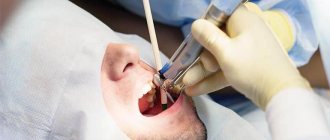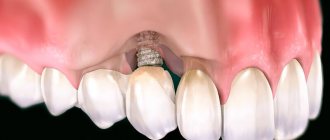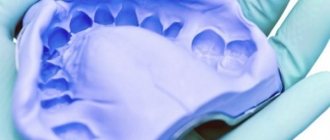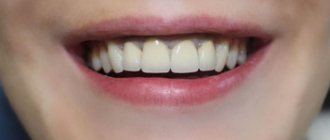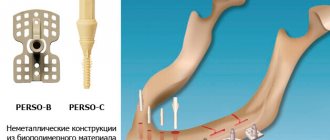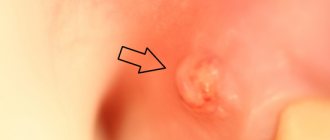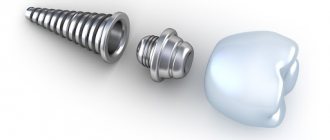Types of materials for sutures in implantology
Dental practice uses several types of suture materials. All of them are classified into self-absorbable and non-absorbable.
Absorbable include
- Catgut;
- dexon;
- vicryl.
Catgut has been used for more than a century and is a classic. The threads dissolve in about two weeks due to the action of phagocytosis and enzymes. The disadvantage of the material is the ability to provoke tissue inflammation due to foreign proteins contained in its composition. The use of catgut during implantation is not recommended.
Dexon and vicryl are synthetic materials. The active substance of the first is polyglycomic acid, the second is polylactin. Resorption is promoted by hydrolysis. The period of complete dissolution takes about a month. Suppuration practically does not occur when using these threads.
Non-absorbable threads
- Silk;
- woven polyester;
- monofilament.
Silk , consisting of silkworm proteins, is often used by surgeons, but not for fixing bone grafts. It has one drawback - sometimes an inflammatory process develops in the area of the sutures. Braided polyester threads serve their purpose well, without complications.
Monofilament sutures with good mechanical properties
are most suitable for implantology They do not cause reactions and are suitable for prolonged contact with the oral mucosa. The only negative aspect of the material is the rough ends. The problem is solved by fixing them with a special bandage.
Stage 5: insertion of the healing abutment
This detail is necessary to give natural contours to the gums in the operated area. The former is screwed directly into the implant rod by cutting the soft tissue.
In essence, the plug is replaced, which is unscrewed, and a former is placed in its place in the implant channel. The manipulation is very simple and quite fast. An experienced implantologist performs it in a matter of minutes, maximum in half an hour, regardless of the type of implant. But an anesthetic injection is still given due to the incision of the mucous membrane.
This is where the main and most serious part of dental implantation ends, and after a week or two they move on to screwing in the abutment.
Care instructions
Regular treatment of the operated mucosal area promotes successful healing. The procedure consists of several stages.
- Daily three-time antimicrobial rinses with Tantum Verde solution.
- To protect the tongue from damage by the hard ends of the threads, it is necessary to smear the operated area with Solcoseryl adhesive paste. It promotes rapid regeneration of the damaged area.
- Drug therapy includes taking Calcium d3 Nycomed, multivitamin complexes, painkillers (if the gums hurt). Anti-inflammatory drugs are prescribed to reduce swelling.
Additionally, the following rules must be observed:
- give up solid food, hot dishes, drinks, hot spices, coffee (increases blood pressure);
- do not use a hard toothbrush;
- avoid intense training and heavy lifting;
- do not visit the sauna, bathhouse;
- stop smoking: cigarette smoke negatively affects the mucous membranes and increases the risk of inflammation.
- The diet should include pureed soups, boiled porridges, and broths.
It is important to maintain oral hygiene to avoid the proliferation of pathogenic microorganisms. You need to brush your teeth carefully, without touching the operated area.
Postoperative nutrition
Avoid hot foods until the anesthesia wears off. If you eat or drink something too hot, you can accidentally burn your gums because they won't feel the temperature.
In the first two days, do not drink coffee: it increases blood pressure and this can lead to bleeding. This also explains the requirement to exclude alcohol and smoking.
Within 10 days after surgery, to strengthen injured bone tissue, include calcium-containing foods in your diet: cottage cheese, kefir, yogurt.
Do not eat salty, spicy, very hot or frozen foods, as well as rough foods - crackers, nuts. The load on the teeth should be reduced as much as possible, so you should avoid foods that require careful active chewing - for example, tough meat.
The best option for a postoperative diet is pureed, semi-liquid, moderately warm food (soups, cereals, smoothies), or finely chopped.
What to do if the suture breaks after implantation
There are times when the threads have weakened and come apart. This does not threaten the implant falling out, but there is a risk of infection . The situation must be corrected urgently.
After the examination, the doctor will take the necessary antiseptic measures and prescribe rinses. The recovery period after long complex operations is sometimes accompanied by antibiotic therapy. The rehabilitation course for each patient is compiled individually. If the tissues have not yet fused, the specialist will have to remove the stitches and then apply new ones.
Sinus lift
Sinus lift or subantral augmentation surgery before implantation can only be performed on the upper jaw. Its essence is to raise the lower septum of the maxillary sinus in order to increase the space of the alveolar ridge. The space thus freed is filled with bone tissue.
On a note! Sinus lifting is scientifically called subantral augmentation.
If there are no contraindications, the implantologist can combine sinus lifting with the installation of implants. Otherwise, the latter are placed in the jaw bone 3-6 months after the subantral augmentation surgery.
Sinus lifting can be open or closed, and its price depends on the chosen method. Open operations are estimated at the amount of 40,000 rubles, closed ones - from 20,000 rubles. It is important to know that this cost does not include the price of the bone material itself.
Suture removal after implantation
Patients are always interested in the question “On what day after implantation are the sutures removed?” Usually, for those whose healing went well and there was no suppuration, the threads are removed after 10-14 days. All this time, the area above the implant must be treated with antiseptics and protected from injury. The first days after surgery, you may feel as if threads are being pulled. Often there is a discharge of ichor. After the thread extraction procedure, which is absolutely painless, the doctor will recommend continuing the preventive course.
Introduction
We hope you did everything correctly before implantation, carried out all the necessary tests and diagnostics, prepared comprehensively, and now, after its successful implementation, all that remains is to follow the following recommendations after dental implantation. But, if you are just preparing for dental implantation, then all the materials in this section will be extremely useful to you. And if you want to place implants with the highest quality and reliability, we recommend contacting our Research Center clinics, which have been successfully operating in Moscow for more than 10 years. And they are the best not only in Moscow, but also in Russia according to dental ratings. Sometimes it is better not to skimp on your health, since you will live with implants for the rest of your life, and the quality and further maintenance of implant systems should come to the fore. Remember the simple folk truth “The miser pays twice”: poorly installed implants can lead to their rejection and inflammation of the bone tissue. Yes, installing implants with us is not cheap, but we solved this problem for you!
Financial support for dental implantation
Do you want to undergo high-quality dental implantation in our clinics, but have a financial problem? This can be solved! From July 20, 2021,
you can use the dental implantation service in installments.
Please note
that some of the material is accompanied by a video from our YouTube channel, we recommend spending a little of your precious time and watching the videos, it will be useful.
More than 1,000 patients
use the recommendations of medical specialists from the Research Center on YouTube every day .
Why is it important to follow the recommendations after implantation?
Firstly
, dental implantation is a serious surgical intervention involving bone tissue deformation.
And it takes time for the bone structure to heal. The recommendations of the attending physician allow the bone tissue to heal and osseointegrate into the dental implant as quickly as possible. Do you know what can result from the fact that the implant does not take root due to your failure to follow the recommendations? Let's read the next point #2, which is also the most important. And this is not a joke, but the sad experience of violating patients. Secondly
, non-compliance with the recommendations sharply increases the risk of developing inflammation at the implant site - peri-implantitis, followed by implant rejection or removal.
Moreover, inflammation can occur both in the first months after installation of the implant, and after a year or two or three. Below we provide clinical examples of peri-implantitis that developed in patients, leading to the removal of the implant. Therefore, be careful and follow the recommendations. In general, high-quality dental implantation is absolutely painless for the patient. The importance and role of implantation in human health cannot be overestimated. The biggest problem with implantation is that there is swelling after the operation. It can last about 3 days
, but even then not always.
After dental implantation, the patient must understand that he will have a certain medication load: he must take antibiotics, antimicrobial drugs, and take baths with an antiseptic. And, of course, follow the doctor’s recommendations.
What to do next
The implantation process is quite long. After the threads are removed, the mucous membrane continues to grow over the implant. It shouldn't be visible. This takes approximately two months. Then prosthetics are performed. Installed orthopedic structures require careful care. The patient needs to master the technique of daily procedures that will help maintain a beautiful, healthy smile for a long time. These include:
- using a brush with soft bristles;
- brushing teeth twice a day;
- flossing;
- cleaning the areas where the implants come into contact with the gums using an irrigator;
- If plaque has formed, visit the dental office to remove it.
Patients who have undergone implantation should periodically visit specialists. This will help extend the service life of structures and avoid complications.
Stage 7: prosthetics
After 1-2 weeks from the installation of the abutment, impressions of the teeth and jaws can be made. Crowns can be made from absolutely any material, but ceramic products are more suitable for front teeth. Implant roots in the area of chewing teeth are complemented by metal-ceramic or zirconium crowns.
The price of prosthetics varies depending on its type, since both crowns and removable, as well as conditionally removable dentures are placed on implants. In addition, the cost is affected by the material they are made of.
On a note! Zirconium is the most expensive, but also the most reliable material, which has high strength and excellent aesthetic qualities.
Long-term complications
During the period of implant healing, when bone formation occurs, the following complications may occur:
- Reimplantitis is an inflammation of the tissues surrounding a dental implant. Most often this occurs due to poor oral hygiene. This process is accompanied by swelling, pain and bleeding of the gums. If inflammation is not treated at the initial stage, it will go into a chronic phase, which leads to the destruction of bone tissue around the implant and disruption of its mobility. In this case, the implant will have to be removed and the bone tissue treated. Please note that the implant can be re-installed only after 3-4 months. This is an extremely rare complication. It occurs in only 1-2% of cases.
- Implant rejection. This is the process of bone rejection of an implanted titanium rod. The cause of this process can be inflammation, violation of surgical technology, bone injury, smoking, exacerbation of chronic diseases (such as diabetes, osteoporosis), and extremely rarely, an allergy to titanium.
This process is manifested by implant mobility and pain in the surgical area. To treat this complication, the implant is removed and special therapy is prescribed to treat the cause of rejection. This is a very rare complication, the probability of occurrence of which is less than 1%7.
How to avoid complications?
“It turns out that implantation is a dangerous operation?” - you ask. This is not entirely true. In modern dentistry, the success rate of this operation is more than 95%. But in order for everything to go well, strict adherence to the basic rules is necessary:
- Choosing a clinic and doctor. This is the main key to success! The clinic must be equipped with all the necessary equipment, and the implantologist must have all the necessary skills to perform the operation. On the clinic’s website or directly at the appointment, you can familiarize yourself with the necessary certificates and licenses. The work of the clinic’s specialists is often written about on the Internet.
Carefully study the guarantees that the clinic provides you. Typically, all details of treatment are described in detail in a voluntary informed consent, which the patient signs before the procedure. The clinic doctor is obliged to discuss with you all questions that you may have
- Preparing for surgery. Proper preparation is the key to success. We have already written about the features of this process in one of the previous articles.
- Compliance with doctor's recommendations. In addition to taking medications prescribed by a doctor, it is necessary to maintain oral hygiene, follow a regimen during the postoperative period, and be attentive to your health.
